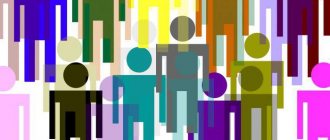“Social” is an adjective derived from the noun “socium” - “society”. In the modern Russian language there are many terms that are somehow related to the word “social”: social status, social responsibility, social security, social psychology... The list goes on. Most of its elements are firmly integrated into the everyday life of modern people, but it is impossible to understand what they mean if you do not know the meaning of the concept “social” itself.
What is the social essence of man?
Social essence is a person’s ability to control his instincts, suppress and regulate his desires, engage in meaningful and purposeful activities, and comply with the rules accepted in society. Social essence determines our behavior and the types of activities that we allow ourselves in everyday life.
Among the many biological species inhabiting our planet, man stands out precisely because of his social essence. Of course, many animals also unite in packs and other communities, but they do this under the influence of instincts. People, on the contrary, are able to overcome instincts to fulfill their social roles.
As examples of the manifestation of a person’s social essence, the following can be noted:
- overcoming primitive instincts and “primitive feelings”;
- desire to change the world for the better;
- the need for active activity that is useful for society;
- the ability to improve and overcome one’s weaknesses;
- the ability and need to set goals and achieve them;
- the need for communication and other forms of interaction;
- need for recognition and respect.
If you look at Maslow's pyramid, you will notice that the first two levels are related to the satisfaction of basic biological needs. But the levels located above reflect various aspects of a person’s social essence.
Social status and social role
The concepts of status and role are not identical, although they are inextricably linked. Social status is the place occupied, and social role is the expectations from a person based on this occupied status. There are two main directions in social role. These are standard, habitual and socially prescribed expectations, and how a person realizes himself in accordance with this, i.e. how the stereotypical socio-role model is fulfilled or violated at the behavioral level.
Status is characterized by achievements, and other indicators are used to indicate social role. This includes the level of emotionality required to perform the role, the method of obtaining it (given from birth, for example, gender or acquired, for example, the status of a mother), the scale of manifestation (some social roles have a clear time or geographical framework for manifestation, others require performance constantly) . In addition, roles can be established or arbitrary, which is impossible with status, and roles change several times a day; changing status requires more time. The number of social roles corresponds to the number of social statuses. Being the mother of a child by status, she requires the fulfillment of certain responsibilities at the role level. In many ways, this causes serious internal conflicts and contradictions when a person faces the choice of fulfilling the expectations of different roles. Professional and family roles often collide, forcing a person to choose to perform only one thing, because it is impossible to simultaneously attend an important meeting and a children's party.
Including the expected sequence of actions performed, the social role in many ways makes a person hostage to his own achievements. Thus, doctors will be expected to be constantly ready to help, from convicted deception or theft, and the boss will be expected to accept responsibility and implement error-free decisions. In another society, this may be perceived completely differently, since different social statuses and roles have different attitudes. In some countries, parents drop off and pick up their children from school up to high school, while in others, seven-year-old children travel a two-hour journey with several transfers on their own.
Failure to fulfill expected social roles usually results in punishment. This could be social censure from society and non-acceptance of such a person into one’s circle, or it could be a legal punishment (deprivation of parental rights if the mother does not perform parental functions, dismissal or even imprisonment). The inconsistency of human behavior with its role causes a lot of indignation in society, because threatens to undermine the entire system of predictability, order and security. This is regulated by generally accepted moral norms, which in many ways may contradict the internal feelings of the individual. A priest listening to hard rock will cause bewilderment, and playing in a rock band may incur public persecution. Moreover, his behavior will not contradict the rules prescribed by the role of the clergyman, but the fact that the behavior does not fit into the ideas and expectations of the majority is considered a deviation from the given social role.
In addition, many social statuses require the performance of several social roles. The status of a wife includes the role responsibilities of a nurse, a doctor, a cleaner, a mistress, and so on. The social status of the director may include fulfilling all the professional roles of the present employees.
The presence of such a framework and a strict requirement to comply with social roles makes people’s lives and behavior more predictable, which directly affects the level of general social security and the reduction of internal feelings of anxiety in each individual. This system of role expectations as control of society begins and is instilled from early childhood. This process is called socialization, when through play and explanations from adults, watching films and reading fairy tales, observing people around, the child absorbs and remembers the rules of behavior in society. This is the basis for the difference between children's games - girls swaddle baby dolls, and boys build castles, thereby preparing for further adult roles. Parents teach their children in the same way - girls are involved in helping with housework, boys in household repairs. Raising princesses differs significantly from raising rural children, and instills completely different behavioral skills required by status.
Strict fulfillment of roles and the presence of certain stereotypical expectations allows you to speed up the communication process and increase the degree of trust. When entering a doctor’s office, every person listens to his advice and uses help. If there were no social roles determined by social status, then initially it would be necessary to check the availability of diplomas, their authenticity, triple the practical examination of the skills acquired by the doctor, and then for a long time deal with the internal motives of his activities.
Differences between social essence and biological
As we have already found out, man is a biosocial being with a dual nature. The biological essence, which is the result of evolution, is combined in it with the social essence - the product of the development of society. They both have a significant impact on all aspects of human life and behavior. Moreover, each of them has certain features:
- The biological essence is manifested in the fact that a person is an ordinary animal with his own needs and instincts aimed at their realization. The basic biological needs of humans are the maintenance of life, reproduction and protection of offspring.
- The social essence is manifested in the fact that a person, being part of society, is able to control his instincts, suppress and regulate his desires, engage in meaningful and purposeful activities, and follow the rules. Social essence, like personality, is formed in the process of socialization.
Different authors speak differently about the relationship between the biological and social essences of man. Some contrast them, while others consider them closely related. The second point of view is more popular. It implies that a person has a biological essence from birth, but as he grows up and socializes, the social one plays an increasingly important role. At the same time, it is also aimed at realizing human needs, but through adaptation to the complex requirements of human society.
How do antisocial people behave?
The psychological portrait of an antisocial person may vary, but the main feature is his avoidance of social contacts wherever possible. That is, sometimes antisocial people literally become hermits-downshifters: they live in sparsely populated villages, minimize economic relations with the “big world”, try to survive by subsistence farming, etc. But, as you understand, there are few such unique people.
Hikikomori (hikki) - people who deliberately refuse communication and socialization, striving for extreme isolation
A more common type is people who rarely leave home and do not strive to make acquaintances and socialize.
Sometimes, out of a sense of responsibility, they try to study and work with minimal contact with people - they choose remote work, etc.
But if given the option of living without providing for their needs through real activities among other people, they will certainly take advantage of it. This type includes hickeys, gambling addicts, infantile “mama’s boys,” etc.
Also asocial are marginal individuals - those who are prone to vagrancy, leaving home and families, who do not strive to have personal income, and who do not try to develop in any way as a person.
Are antisocial people mentally ill?
Often, yes: many psychiatric diagnoses include persistent antisocial behavior or episodes of antisocial behavior. For example, people who are severely depressed become antisocial.
But sometimes asociality is a consequence of current life circumstances, an unfavorable environment. For example, a difficult teenager may run away from home, where he feels bad, or isolate himself from the society of peers, among whom he experienced bullying. Under good circumstances, such a teenager will be able to socialize.
The formation of the social essence of man
You've probably heard the saying, "Work made a man out of a monkey." So it's not as meaningless as it seems. Indeed, labor aimed at satisfying one’s own needs and the needs of one’s tribe played a significant role in the transformation of man into a social being. Collaborative labor represented historically the first form of social interaction between people.
Initially, people engaged in joint production - hunting and gathering, then they learned to jointly grow crops and engage in other forms of production. With the advent of material values, which did not arise on their own, but were produced by people, such concepts as property and power began to form.
Over time, social interaction between people in the same tribe, as well as between neighboring tribes, became increasingly diverse. In particular, people realized that they could not only own resources, but also exchange them for those that were needed at the moment. Paleontologists say that people learned to trade and exchange during a period called the “Neolithic Revolution.” It is this event that can be considered the moment of formation of the social essence of man.
Alternative meaning
Social is not only related to public life. Sometimes this term characterizes something that radically changes this life, makes significant amendments to it, and sharp and radical ones.
A revolution or a revolution can be social. The meaning of the word “social” in this case is changing social life. The most striking examples of such changes are the English Revolution in the seventeenth century and the Great French Revolution in the eighteenth.
Social personality traits
Personality is a concept that reflects the social nature of a person. That is, this is not just an individual, but a subject of social relations, a member of society, possessing a unique set of socially significant traits. In sociology there are two approaches to the study of personality:
- A person is considered as an active subject, capable of cognizing and changing the world around him, influencing society, assessing himself and his place in society. Within the framework of this approach, social qualities of a person are considered to be those qualities that determine a person’s lifestyle, his self-esteem and his assessment by other members of society.
- Personality is considered as a set of social functions and roles. A person simultaneously performs several functions in different areas of life. Within the framework of this approach, social qualities of an individual are qualities that are formed and developed in the process of interaction with other members of society.
Basic social qualities of a person:
- self-awareness – the ability to be aware of oneself, evaluate one’s actions and understand how others evaluate them;
- self-esteem is a complex characteristic that shows how a person perceives his abilities, capabilities and other characteristics;
- social identification – identification by a person with a certain social group;
- activity – the ability to perform socially significant actions, take initiative when interacting with others;
- interests are the source of motivation necessary for active actions;
- beliefs - moral, ideological, religious and other views that determine a person’s perception of the world around him;
- life goals are global goals that a person perceives as his destiny.
From a psychological point of view, the presence of life goals is a key characteristic of a mature personality . Despite all the variety of possible options, all existing life goals can be grouped into four groups:
- material goods and comfort;
- development and creative activity;
- power and respect;
- spiritual improvement.
Causes of antisocial behavior
People are made antisocial, not born, although biological factors also have some predisposition but do not have a key influence on the development of sociopathic traits. Hereditary factors create a tendency toward criminal behavior, but solely due to high rates of impulsiveness and infantilism, which can be compensated for with proper upbringing. The negative effects of smoking, alcohol and drugs during pregnancy prevent the nervous system from developing normally, resulting in not only emotional disruptions, but also self-control and the ability to understand others.
Even with the healthy formation of the nervous system and the development of the fetus without genetic abnormalities, asociality develops in negative conditions of family life. When violence is used against a child as a guiding factor of behavior, the general atmosphere is negative and aggressive, then the emotional sphere collapses and social distancing occurs.
Excessive coldness and indifference on the part of adults (especially typical when parents are not ready for birth) forms a closed personality, with the understanding that indifference and pursuit of only one’s interests is the only way to exist.
Children with hyperactivity largely owe their future to their parents and their attitude, since such an indirect feature of the nervous system can easily develop into asociality if left to chance or shown excessive cruelty.
Leaving such children often unattended increases the risk of criminal patterns of behavior based on the principle of permissiveness. And while this happens within the walls of a house without adults, an imprint remains in the psyche that in the big world you can behave as you please, despite knowing the official prohibitions. The younger the child, the easier he obeys the rules of adults (parents or passers-by), therefore reducing the likelihood of contact with unstable elements is the prevention of asociality.
The environment also influences, for example, in countries where the population density is high, and all possible work is connected with contacts, people rarely become asocial, only under the condition of serious biological factors. If a person has a choice regarding his activities and he is not satisfied with the situation around him, then asociality is a conscious choice. This happens in a situation where a person and her level of culture do not correspond to those around her - when a modest, intelligent girl lives in a village where they communicate with obscenities and drink regularly, then distancing yourself from such a society, going online to make money and completely ignoring their norms and requirements may be the only salvation.
It turns out that the reasons for asociality can appear before birth and after mid-life, depending on the mental structure and the environment, but in any case, this quality cannot be attributed exclusively to negative or positive. In some situations this leads to the development of deviant behavior, crimes and disruption of social ties, in others it helps to save one’s own internal structure and psyche.
Self-awareness and self-realization
Self-awareness and self-realization are important “building blocks” of a person’s social essence. Self-awareness is the ability of an individual to understand himself as a person, evaluate his capabilities and abilities, understand and predict how certain actions will be perceived by others, and also take responsibility for his own decisions and actions. It is self-awareness that determines how successfully a person can interact with other members of society.
Self-realization is the process of a person realizing his potential, achieving life and simply important goals. American psychologist Abraham Maslow believed that the need for self-realization is one of the highest human needs (along with self-actualization and self-development). He gave the following definition: self-realization is the fullest use of all talents, abilities and available opportunities to carry out personally significant activities.
Characteristic manifestations
Social and antisocial people differ on the basis of relationships in society, the presence or absence of moral principles, and compliance with social norms.
Asociality can manifest itself starting from primary school age. Most often observed during adolescence. In childhood, this behavior may manifest itself in the following ways:
- the child begins to deceive his parents and his peers;
- loss of interest in learning at school;
- there are no friends, there is no need to communicate with peers;
- the child may be aggressive, get into bad company, start committing crimes;
- leaves home, disappearing for several days, there is a tendency to wander; upon returning, the child says that he will not run away again, however, he does not keep his promise;
- exhibits aggressive behavior towards weaker people and animals.
An adult can be given the following manifestations indicating his antisocial behavior:
- the presence of an unfair attitude towards work - a person may skip work, be constantly late, be negligent in his duties, or not engage in work activities at all;
- inability to plan your future, which leads to frequent changes of partners, place of residence, and work;
- lack of ability to express one’s own emotions (so polar feelings can manifest themselves in hysterics);
- feels a desire to satisfy his own needs without thinking about the needs of other people (selfish, does not feel shame);
- refuses to fulfill material obligations (does not want to pay alimony, repay debts, help his low-income relatives);
- shows a tendency to aggressive behavior and is capable of crime. Aggression is usually directed at a spouse, young children, or elderly parents.
Common signs also include:
- conflict;
- lack of friends;
- mood swings;
- low, high self-esteem;
- problems with concentration;
- decreased or increased appetite;
- sleep problems, particularly insomnia.
Antisocial people can be recognized by the way they react violently and painfully to their feelings of dissatisfaction and crave getting rid of situations and objects that bring them a feeling of discomfort. Such individuals are usually impulsive and excellent liars. However, sometimes they may not be recognized by others, as they are able to wear masks of intelligent people.









